This Five Grain Sourdough Rye is made with rye sourdough and a multigrain soaker which gives it a delicious whole-grain flavor even though it includes a high proportion of white bread flour.
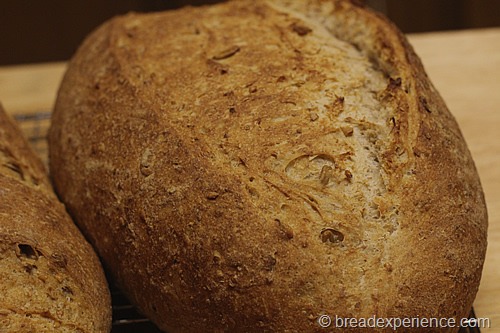
The grains provide a nutty and chewy texture and the high-gluten flour provides the strong gluten structure that is needed for a bread containing this many grains.
I substituted rye flakes for the rye chops so I used a cold soaker instead of a hot soaker. I also used home-milled wholegrain rye flour so I added more water than the original formula called for. Home-milled flour tends to require more water to achieve the appropriate hydration.
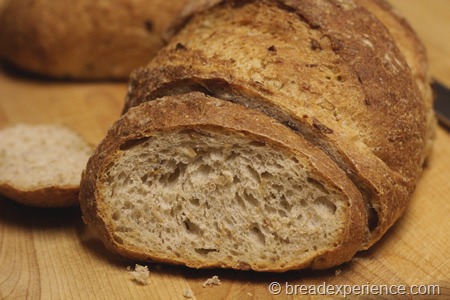
This is a very light bread considering the high amount of grains that are included. It also has great keeping qualities due to the moisture retention in the overnight soaker and the sourdough.
All in all, this is a great bread! I’m glad I made three loaves. I was able to give two away and keep one to enjoy.
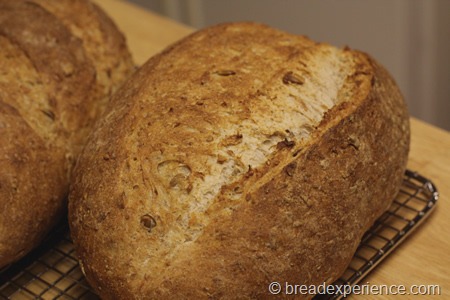
This bread tastes really good plain, but it also tastes good warm with butter. It is a very light bread.
Five Grain Sourdough Rye
Makes: 3 Loaves
Adapted from Bread: A Baker’s Book of Techniques and Recipes by Jeffrey Hamelman
Sourdough:
- 8 oz (1 3/4 cup) whole-rye flour
- 6.7 oz (7/8 cup) water
- 4 oz (1 T + 1 tsp) Mature sourdough culture
Cold Soaker:
- 2.9 oz (1/2 cup) Flaxseeds
- 2.9 oz (5/8 cup) Rye flakes
- 2.4 oz (1/2 cup) Sunflower seeds
- 2.4 oz (3/4 cup) Oats
- .7 oz (3 1/2 tsp) salt
- 1 5/8 cup water, cold
Final Dough:
- 1 lb, 8 oz (5 1/2 cups) high gluten flour
- 12 oz (1 1/2 cup) water
- .19 oz (1 3/4 tsp) instant yeast
- .5 oz (2 tsp) honey
- all of the soaker, above (1 lb, 8.5 oz)
- all of the sourdough, above 14.7 oz (minus 1 T + 1 tsp)
Making the Sourdough:
Prepare the sourdough and let it ripen for 14 to 16 hours at 70 degrees F. I prepared it early in the morning and placed it in the unheated oven all day to ripen.
Preparing the multigrain soaker:
Prepare the soaker at the same time as the sourdough. I started the sourdough and the soaker at about 2:45 am. At 5 pm, I made the loaves following the process outlined below:
Mixing the Dough:
Add all of the ingredients in a mixing bowl and mix on first speed for 3 minutes. Check the hydration. Since I used home-milled wholegrain rye flour, my dough needed a bit more water than the original formula. The dough should be moderately loose and somewhat sticky. Mix for another 3 to 4 minutes on second speed. There should be a reasonable amount of gluten development. The desired dough temperature should be 78 degrees F.
Bulk Fermentation:
Let the dough ferment for 1 hour with no folds.
Diving and Shaping the Dough:
Divide the dough into three 1.5 pound pieces. My pieces came out to about 1.65 pounds each. I decided to shape each piece in a torpedo shape.
Begin by shaping each piece into a round. Cover the balls with plastic and let them rest on a lightly floured counter.
Next, flatten the dough into a rough rectangle. Gently fold the bottom third of dough letter style, up to the center and press to seal, creating surface tension on the outer edge.
Fold the remaining dough over the top and use the edge of your hand to seal the seam closed and to increase the surface tension all over.
Turn the dough over and gently rock it to shape it into a uniform-looking torpedo shape.
Final Fermentation:
Place the loaves on parchment paper and cover them with plastic. Let the loaves proof for 50 to 60 minutes at 80 degrees F. It wasn’t that hot in my kitchen but the loaves proofed in about 50 minutes.
Scoring the Loaves:
I decided to experiment by scoring two of the loaves with three diagonal slashes and one loaf with a slash down the middle.
The one with the slash down the middle turned out so good I wish I had scored all three loaves that way.
Baking the Loaves:
Preheat the oven to 475 degrees F, with a baking stone on the middle rack and a steam pan underneath.
Place the loaves on the hot baking stone using a baker’s peel or the back of a baking sheet. Fill the steam pan with hot water and close the door of the oven.
Reduce the oven temperature to 450 degrees F. Let the loaves bake for 15 minutes, then reduce the oven temperature to 425 degrees F. Bake for a total of about 40 minutes until the loaves are golden brown.
Remove the loaves to a wire rack to cool completely before slicing and serving.
This bread has been YeastSpotted. Please visit Wild Yeast to view all of the lovely breads in the roundup. Thanks to Frankie (Tartine Bread Experiment) for hosting this week’s roundup.

Mellow Bakers was hosted by Paul at Yumarama. We baked bread from Bread: A Baker’s Book of Techniques and Recipes by Jeffrey Hamelman.
Happy Baking!
Cathy
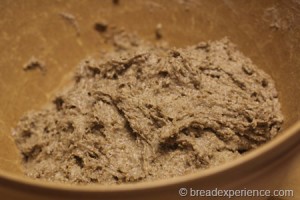
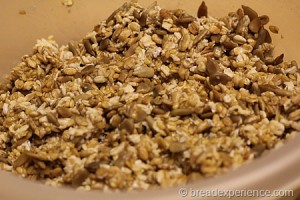
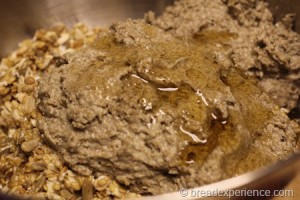
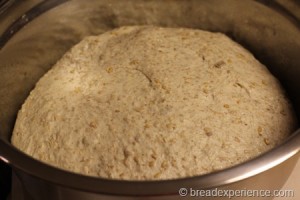
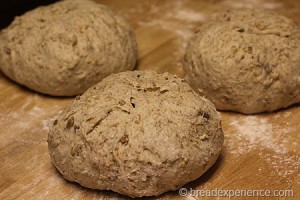
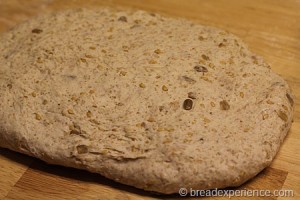
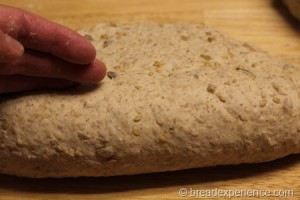
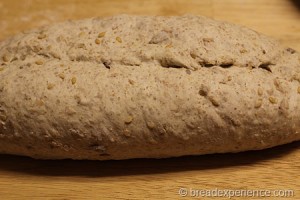
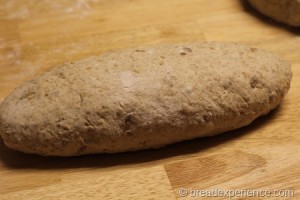
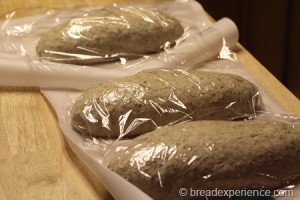
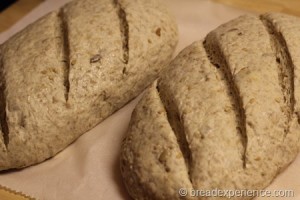
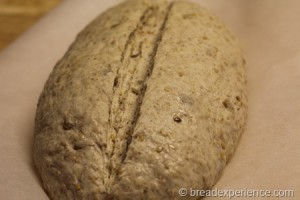
lumpynose says
Looks and sounds very tasty. Is that honey in the final mix picture? I don’t see it in the ingredient list.
Cathy (breadexperience.com) says
Yes, you are correct. That is honey. Thanks for catching that. I’ve updated the list of ingredients to include honey. Happy Baking!
Midnite Baker says
Oh, they look eating yummy!! I’m trying to figure out which is better, a 100 or 166% starter. Any suggestions? M
Cathy (breadexperience) says
I’m more into the art of baking bread than the science so I like to make things really easy. I used 1 tablespoon + 1 teaspoon of my apple starter in this recipe. http://breadmakingblog.breadexperience.com/2011/10/you-are-apple-of-my-starter.html. I maintain my starter by feeding it with 125 grams of flour and 125 grams of water.
naomi dagen bloom says
On a kind of sourdough roll (sorry) this month, I had a terrific experience with your recipe. Made the rye starter with my white one (100-plus years). The soaker was terrific. My only question is salt–what kind are you using–Kosher/sea/table. Thinking I needed more. Made all three loaves, neighbors in retirement community happy. So pleased with result have begun a rye starter (did that in the last century) that I found at Weekend Bakery–this baker suggests rye starter for all loaves.
Using right now for white flour Semolina Sesame from House of Bakes.
Cathy W. says
Hello Naomi,
So glad you enjoyed the bread. I generally use kosher or sea salt. You wouldn’t want to add anymore than .7 oz. The percentage of salt in this formula is 2.2% which is actually a little high. Usually the % used is around 1.8 to 2%. More salt is included in this recipe due to the soaker grains. The sourdough/fermentation is what develops the flavor.
Happy Baking,
Cathy